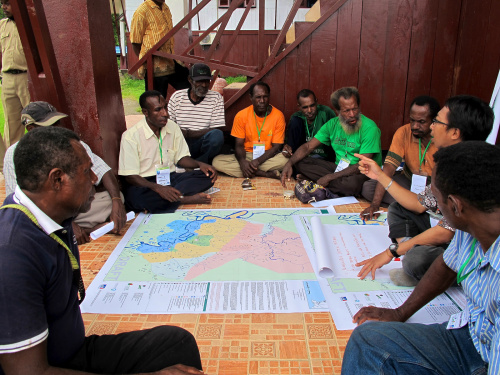MONTPELLIER, France (11 July 2012)_Understanding local people’s perceptions of changes in climate and the perceived impacts on their landscapes and livelihoods could help researchers address the gaps in climate science. This could lead to better strategies aimed at protecting the most vulnerable communities, said CIFOR-CIRAD researcher Manuel Boissière, presenting new unpublished findings at a recent conference in Montpellier, France.
“Climatic data is not always as accurate as people would like to believe it is; weather stations are expensive, can be sparsely distributed, and thus the data can be incomplete,” he explained. “Local knowledge can be used to fill information gaps to give a more complete picture of what is changing in people’s territories, either climatic or other changes.”
“In remote regions local knowledge can be a complementary source of information to meteorological data in order to understand and analyse extreme events, such as flash floods, extreme heat, and high winds.”
Working in Papua, Indonesia, Boissière and his colleagues conducted interviews with people in six villages in the Mamberamo Raya Regency – spanning an area from the mangrove swamps by the ocean to the swamps and mountainous regions upland – gathering detailed information on what changes people believed were taking place in their territories, such as if the seasons seemed unusually dry or wet, or if the forests seemed to be shrinking or growing.
“ This type of research is particularly important to understand how climate variability or change affect people. The first impression we had in this case was that livelihoods were not very sensitive to climate, because of low seasonality, adapted production systems, and the fact that swamps and mangroves act as “buffers” that protect people,” said Boissière.
“However, our research revealed that while communities did not perceive much variation in temperatures and the amount of rainfall during certain months or years, they did notice that extreme events, such as floods, occurred more frequently in the last decade than in the previous ones,” added Bruno Locatelli, CIFOR-CIRAD scientist, also working on the study.
Perceptions are also important, explained Boissière, to identify where the priorities for policy makers should lie. “Local people can give us more detailed and locally relevant information on the things that actually affect their lives,” he said.
For example, villagers overwhelmingly did not think climatic events were key drivers of changes in their livelihoods and landscape, instead identifying infrastructure development, economic activities and new settlements as the main drivers. “This helps understand what policies can be developed in terms of land use planning, natural resource management and adaptation.”
This is important to know in order to plan for the future, and to include local people in decision making. Climate models can vary in their predictions: all of 16 different models that Locatelli looked at predict an increase in local temperatures over the next 80 years, but their estimates for precipitation are not so consistent: most show an overall increase in rainfall, while others predict a decrease.
“We have to accept that the future climate is uncertain. This is why we have to understand how communities are adapting to both excess and lack of rainfall,” said Locatelli.
The study is part of a broader research goal to understand how to integrate local priorities into land use plans, and how local people can play a role in decision-making. The research, conducted with fellow CIFOR researcher Michael Padmanaba and CI staff Ermayanti, used participatory mapping of important resources and local land uses to support policy makers in planning development projects in the region.
Future research into adaptation programmes, Boissière said, should use both the gaps and the similarities between local and technical knowledge as guides to identify future research objectives and as a basis to engage better with local people in common programmes.
This research involved collaboration between three different institutions (CIFOR, CIRAD, CI) and was financially supported by AFD.
We want you to share Forests News content, which is licensed under Creative Commons Attribution-NonCommercial-ShareAlike 4.0 International (CC BY-NC-SA 4.0). This means you are free to redistribute our material for non-commercial purposes. All we ask is that you give Forests News appropriate credit and link to the original Forests News content, indicate if changes were made, and distribute your contributions under the same Creative Commons license. You must notify Forests News if you repost, reprint or reuse our materials by contacting forestsnews@cifor-icraf.org.
